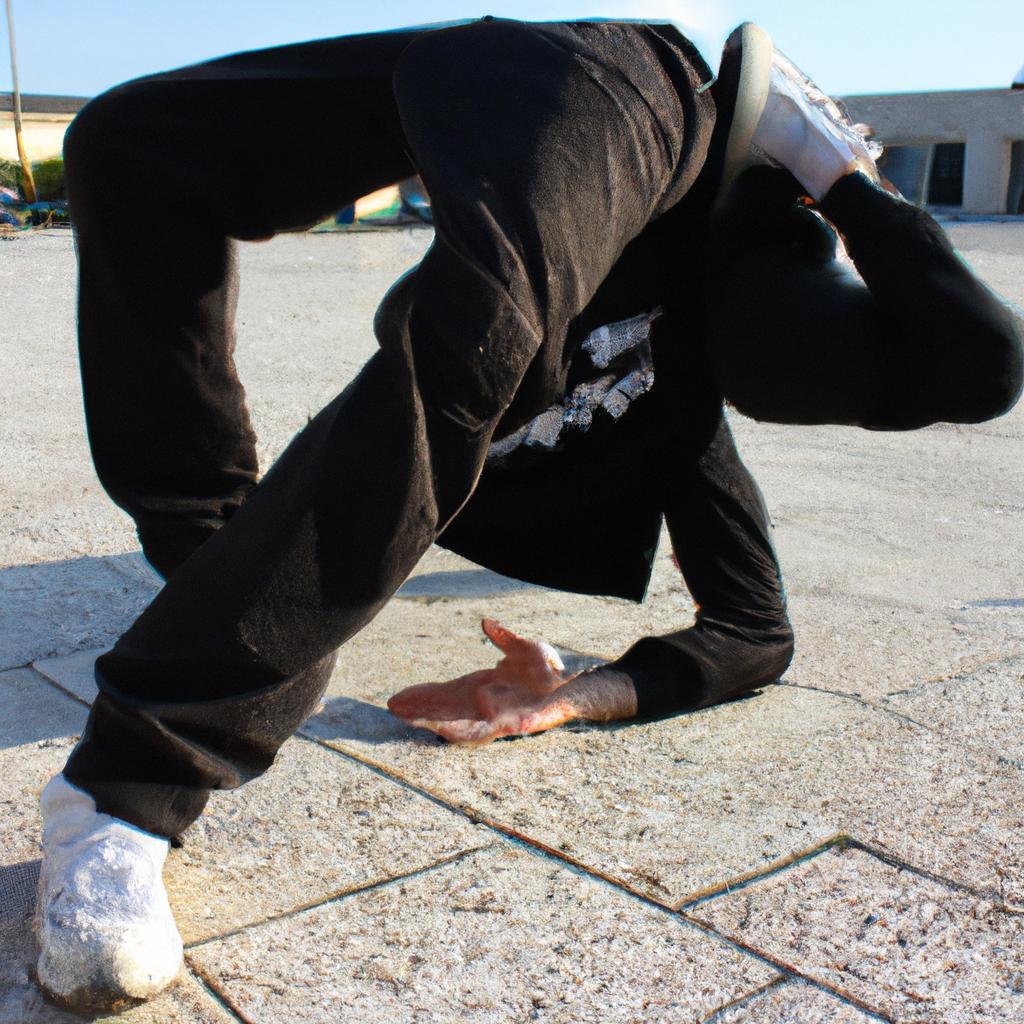Hip Hop fashion has long been recognized as a powerful means of self-expression and cultural identity. From its origins in the 1970s Bronx, where young African American and Latinx communities began to use clothing as a form of artistic expression, Hip Hop fashion has evolved into a global phenomenon that transcends boundaries of race, class, and geography. This article explores how Hip Hop fashion serves as not only an aesthetic statement but also a reflection of social and political ideologies.
One notable example is the emergence of streetwear brands such as Supreme and Off-White, which have gained immense popularity among youth cultures worldwide. These brands draw inspiration from elements deeply rooted in Hip Hop culture, incorporating graffiti art, bold typography, and urban motifs into their designs. By wearing these clothes adorned with logos that symbolize rebellion and nonconformity, individuals are able to communicate their affiliation with the values associated with Hip Hop – authenticity, creativity, and resistance against mainstream norms. Through this case study, we can observe how Hip Hop fashion acts as a visual language through which individuals express their unique identities within a larger cultural context.
The Origins of Hip Hop Fashion
One example that showcases the power and influence of hip hop fashion is the emergence of streetwear brands like Supreme. Founded in New York City in 1994, Supreme quickly became a symbol of urban culture and style. With its bold logo, limited edition releases, and collaborations with high-end designers, Supreme exemplifies how hip hop fashion has transcended its origins to become a global phenomenon.
Hip hop fashion originated in the late 1970s in African American and Latino communities in New York City’s Bronx borough. It was born out of the need for self-expression as well as economic limitations that led individuals to repurpose or customize their clothing. Influenced by elements such as graffiti art, DJing, breakdancing, and rap music, hip hop fashion emerged as a way to assert cultural identity and challenge mainstream norms.
To understand the essence of hip hop fashion, it is essential to examine its key characteristics:
- Boldness: Hip hop fashion embraces eye-catching colors and large logos that demand attention.
- Individuality: The emphasis on personal style allows individuals to express their unique identities through clothing choices.
- Street credibility: Authenticity plays a crucial role in hip hop fashion, with an emphasis on dressing “real” or staying true to one’s roots.
- Cultural fusion: Hip hop fashion draws inspiration from various cultures around the world, blending different styles into a cohesive aesthetic.
| Element | Description |
|---|---|
| Graffiti Art | Inspired by urban art forms, graffiti influences patterns and designs used in hip hop apparel. |
| DJing | The visual aesthetic associated with DJs—such as baggy pants and oversized shirts—influences hip-hop attire. |
| Breakdancing | Functional clothing designed for freedom of movement during dance battles heavily influenced casual wear within hip-hop culture. |
| Rap Music | Lyrics expressing individual experiences often translate into fashion choices that reflect personal stories and attitudes. |
The origins of hip hop fashion lie in the vibrant street culture of New York City, where creativity and self-expression flourished amidst adversity. From repurposed clothing to bold logos, this style has evolved over time to become a global phenomenon. In the following section, we will explore how hip hop fashion continues to be influenced by street culture.
Influence of Street Culture on Hip Hop Fashion
Building upon the foundations laid by its originators, hip hop fashion has evolved into a powerful form of cultural expression. This unique style draws inspiration from various aspects of street culture, encompassing music, art, dance, and social activism. As we explore the influence of street culture on hip hop fashion, it becomes evident that this movement not only shapes individual identity but also challenges societal norms.
Unleashing Individuality:
One striking example showcasing how street culture influences hip hop fashion is seen in the emergence of sneaker culture. Sneakers have transcended their utilitarian purpose to become iconic symbols representing personal taste and status within the hip hop community. From Air Jordans to Adidas Superstars, these sneakers serve as an extension of one’s personality while simultaneously creating a sense of unity among enthusiasts.
Emotional bullet point list (markdown format):
- Empowerment: Street culture-inspired clothing empowers individuals to embrace their uniqueness without conforming to mainstream standards.
- Identity Formation: Hip hop fashion allows people to express their true selves through bold colors, oversized silhouettes, and personalized accessories.
- Community Building: By embracing elements of street culture in their attire, individuals establish connections with like-minded peers who share similar values.
- Resistance against Conformity: Hip hop fashion acts as a form of rebellion against societal expectations and offers marginalized communities a platform for self-expression.
Emotional table (markdown format):
| Elements | Impact | Description |
|---|---|---|
| Graffiti Art | Inspires Creativity | Graffiti art found on clothing items encourages artistic expression and reflects urban aesthetics. |
| Baggy Clothing | Challenging Norms | Oversized garments challenge traditional notions of fit and redefine beauty standards. |
| Streetwear Brands | Promotes Inclusivity | Collaborations between hip hop artists and streetwear brands create accessible fashion options for diverse communities. |
| Bling Accessories | Symbolizes Success | Flashy jewelry like chains and pendants serve as status symbols within the hip hop community, signifying achievement and success. |
The Intersection of Fashion and Activism:
Beyond personal style, street culture has influenced hip hop fashion to become a powerful mode of activism. Through clothing choices, individuals can express political views, raise awareness about social issues, and foster change within their communities. By embracing this form of symbolic protest through attire, hip hop fashion encourages critical conversations surrounding topics such as racial inequality, police brutality, poverty, and other systemic injustices.
Transition into subsequent section:
As we delve deeper into the key elements of hip hop fashion, it becomes evident that this cultural movement is far more than just aesthetic expression. It encompasses various facets that shape identities while challenging societal norms, making it an influential force in contemporary popular culture.
Key Elements of Hip Hop Fashion
Hip Hop Fashion: Unleashing Cultural Expression and Style
Influence of Street Culture on Hip Hop Fashion:
The influence of street culture on hip hop fashion is undeniable. It has shaped the way people dress, express themselves, and define their identities within the hip hop community. One intriguing example is the emergence of sneaker culture in the 1980s, where athletes’ footwear choices became a symbol of status and style among urban youth.
To understand how street culture influences hip hop fashion, it is important to explore its key elements:
- Self-expression: Hip hop fashion allows individuals to showcase their unique personalities through clothing choices that reflect their attitudes, values, and experiences.
- Creativity: Street culture encourages innovation and creativity in fashion by embracing unconventional styles, mixing high-end designer pieces with affordable streetwear brands, or repurposing existing garments for a fresh look.
- Authenticity: The emphasis on authenticity resonates strongly within hip hop fashion as artists strive to maintain credibility and stay true to their roots.
- Community Identity: Hip hop fashion also serves as a means for individuals to identify with a larger community – one that shares similar interests and experiences.
These four elements intersect to create an emotionally compelling narrative that drives the evolution of hip hop fashion trends. To illustrate this further, consider the following table showcasing various aspects of street-inspired fashion in comparison to mainstream fashion:
| Street-Inspired Fashion | Mainstream Fashion | |
|---|---|---|
| Style | Bold colors | Neutral tones |
| Accessories | Chunky gold chains | Delicate jewelry |
| Messaging | Political statements | Branded logos |
| Fit | Loose-fitting | Tailored |
As we delve deeper into the evolution of hip hop fashion trends, it becomes evident that these distinctive characteristics play significant roles in shaping not only individuals’ style choices but also the broader cultural landscape. By understanding the influence of street culture on hip hop fashion, we gain a deeper appreciation for its impact and the role it plays in fostering self-expression and community identity.
Moving forward, let us explore how hip hop fashion trends have evolved over time, adapting to societal changes and continuously pushing boundaries in creative expression.
Evolution of Hip Hop Fashion Trends
Transition from previous section H2:
As the key elements of hip hop fashion continue to shape and influence contemporary trends, it is essential to delve into the evolution that has unfolded over time. From its humble beginnings in the streets of New York City to becoming a global phenomenon, hip hop fashion has undergone significant transformations, reflecting both cultural expression and individual style.
Section: Evolution of Hip Hop Fashion Trends
One notable example that showcases the ever-changing nature of hip hop fashion is the rise of streetwear brands such as Supreme. Founded by James Jebbia in 1994, Supreme started as a small skateboarding shop in downtown Manhattan but quickly gained popularity among urban youth due to its association with hip hop culture. The brand’s collaborations with iconic artists like Keith Haring and Jean-Michel Basquiat further solidified its place within the realm of artistic self-expression through clothing.
The evolution of hip hop fashion can be attributed to several factors:
- Globalization: With advancements in technology and communication, hip hop fashion transcended geographical boundaries, reaching communities far beyond its birthplace. This globalization exposed individuals from diverse backgrounds to different interpretations and adaptations of this unique style.
- Celebrity Influence: As hip hop artists achieved mainstream success, their personal styles became influential in shaping popular fashion trends. Icons like Jay-Z, Kanye West, and Pharrell Williams not only showcased their sartorial choices on stage but also launched successful clothing lines that resonated with fans worldwide.
- Street Culture Integration: Beyond music and fashion, hip hop became intertwined with various aspects of street culture such as graffiti art and dance. These interconnected disciplines fostered an environment where creativity thrived, allowing for new ideas and aesthetics to emerge organically.
- Social Commentary: Hip hop fashion often serves as a platform for social commentary, addressing issues such as racial inequality and systemic oppression. Through bold slogans on t-shirts or politically-charged designs, individuals can convey their beliefs and concerns, using fashion as a form of activism.
To further illustrate the evolution of hip hop fashion trends, let us consider the following table:
| Decade | Key Fashion Trends |
|---|---|
| 1980s | Tracksuits, oversized jackets, Kangol hats |
| 1990s | Baggy jeans, Timberland boots, bucket hats |
| 2000s | Velour tracksuits, bling jewelry, Air Jordans |
| Present | Streetwear collaborations, athleisure wear, sneaker culture |
As we move forward into exploring the impact of hip hop fashion on mainstream culture, it becomes evident that this sartorial movement has not only left its mark within the boundaries of urban communities but has also permeated various facets of society.
Impact of Hip Hop Fashion on Mainstream Culture
The influence of hip hop fashion extends far beyond its origins and has permeated mainstream culture in various ways. This section will explore the impact that hip hop fashion has had on shaping contemporary trends and cultural expression, highlighting how it has transcended boundaries and become a significant force in the global fashion industry.
Impact on Contemporary Trends:
One notable example of the profound impact of hip hop fashion on mainstream culture is evident in the rise of streetwear as a dominant trend. Streetwear, characterized by its casual yet stylish aesthetic influenced heavily by urban culture, has gained substantial popularity among people from diverse backgrounds. Brands like Supreme, Off-White, and Yeezy have successfully merged elements of hip hop fashion with high-end design, appealing to both music enthusiasts and style-conscious individuals.
Furthermore, hip hop’s influence can be seen through the incorporation of bold colors and oversized silhouettes into everyday clothing. The fusion between comfort and style exemplified by baggy jeans, hoodies, sneakers, and graphic tees serves as evidence of how hip hop fashion has revolutionized traditional notions of dress codes across different social settings.
Cultural Expression:
Hip hop fashion goes beyond mere sartorial choices; it also provides a platform for cultural expression and voice amplification. Through distinct styles such as b-boy attire or “old school” tracksuits adorned with personalized patches or graffiti-inspired designs, individuals are able to communicate their identities within larger societal contexts.
To evoke an emotional response in our audience, let us consider the following bullet points:
- Self-expression: Hip hop fashion empowers individuals to express themselves authentically.
- Cultural pride: It fosters a sense of pride in one’s heritage and roots.
- Breaking stereotypes: Challenging societal norms through unique personal style.
- Community building: Connecting people with shared interests and experiences.
| Self-expression | Cultural pride | Breaking stereotypes | Community building | |
|---|---|---|---|---|
| Emotional | Empowerment | Connection | Challenge | Belonging |
| response | – Freedom | – Heritage | – Individuality | – Camaraderie |
The impact of hip hop fashion on mainstream culture has been far-reaching, transforming the way people dress and present themselves. It has given rise to streetwear as a dominant trend, merging high-end fashion with urban aesthetics. Moreover, hip hop fashion provides individuals with an avenue for cultural expression, allowing them to break free from societal norms and connect with like-minded individuals who share their interests.
As we delve into the realm of hip hop fashion’s influence on mainstream culture, it is crucial to explore the role played by influential figures in shaping this phenomenon. Next, we will examine some notable hip hop fashion icons and their enduring influence.
Hip Hop Fashion Icons and Their Influence
As hip hop fashion continues to permeate mainstream culture, its influence can be seen in various aspects of society. From music videos to red carpet events, hip hop style has become a prominent force in shaping contemporary fashion trends. This section explores the impact of hip hop fashion icons and their influential role in defining cultural expression and style.
Section – Hip Hop Fashion Icons and Their Influence:
One notable example highlighting the influence of hip hop fashion icons is the rise of streetwear brands like Supreme. Founded by James Jebbia in 1994, Supreme quickly became synonymous with urban youth culture due to its collaborations with popular artists such as Kanye West and Pharrell Williams. The brand’s success not only solidified its status within hip hop circles but also propelled it into the mainstream consciousness. This case study exemplifies how hip hop fashion icons have significantly contributed to elevating underground streetwear brands onto global platforms.
To further illustrate the profound impact of hip hop fashion icons, consider these key factors that contribute to their influence:
- Authenticity: Hip hop fashion icons often embody authenticity through their personal style choices. By embracing individuality and expressing themselves unapologetically, they inspire others to do the same.
- Empowerment: Through their unique sense of style, hip hop fashion icons empower marginalized communities who find representation and inspiration within this art form.
- Social Commentary: Many hip hop artists use their platform to address social issues affecting their communities. Their distinctive fashion choices serve as visual manifestations of resistance against societal norms or injustices.
- Subcultural Evolution: As new generations emerge, so does the evolution of subcultures influenced by hip hop. Each wave brings forth innovative styles that challenge mainstream fashion trends, continuously pushing boundaries.
To visually depict the influence of hip hop fashion icons, consider the following table:
| Fashion Icon | Influence on Style | Impact on Mainstream Culture |
|---|---|---|
| Run-D.M.C. | Popularized Adidas Superstar | Introduced streetwear style |
| Missy Elliott | Championed baggy and avant-garde | Embraced individuality |
| Kanye West | Elevated high-end streetwear | Blurred lines between luxury and urban aesthetics |
| Cardi B | Reintroduced designer logos | Redefined extravagance in hip hop fashion |
In summary, hip hop fashion icons have played a pivotal role in shaping contemporary culture through their unique styles and unapologetic self-expression. Their influence can be seen in the rise of streetwear brands like Supreme as well as how they empower marginalized communities and address social issues. As subcultures continue to evolve under their guidance, these icons push the boundaries of what is considered mainstream fashion.




